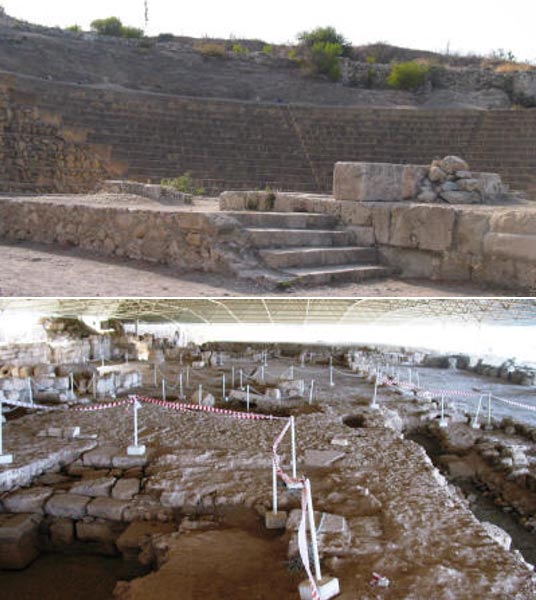
2,400-Year-Old Aristocrat Family Tomb Uncovered in Cyprus Sheds Light on Ancient Soloi
Details on the 2,400-year-old tomb belonging to a rich family that was excavated in Soloi (Soli), Northern Cyprus from 2005-2006 are being unveiled. Jewelry, weapons, human remains, figurines, and symposium vessels were awaiting the archaeologists that found the tomb and the early analysis of these artifacts is providing a glimpse into the social structure and trade practices of ancient Soloi.
The tomb complex consists of three burial chambers, one of which was looted. The others contained the aforementioned artifacts. Of these objects, one of the most impressive is a golden wreath in the shape of an ivy plant, complete with details such as berries.
These goods led the archaeologists to make the claim that the tomb belonged to an aristocratic family. In one of the chambers the remains of a man, woman, and young girl were found. There were also a woman and young girl present in another chamber. The looted chamber did not contain any human remains. The archaeologist who studied the Soloi tomb complex, Hazar Kaba, told Live Science that: "A DNA project is running on the bones to identify the degree of kinship between the deceased."
Kaba also asserted that the artifacts further suggest that there was trade between Soloi and Athens 2,400 years ago:
"This tomb complex surely proves that Soloi was in direct relationship with Athens, who was the naval power of the period. Soloi was supplying Athens with its rich timber and copper sources, and in return, was obtaining luxurious goods such as symposium vessels.”

Symposium vessels of bronze, silver, and gold-silver from the tomb complex at Soloi, Cyprus. (Kadir Kaba)
- The Ancient Ruins of Salamis, the Once Thriving Port City of Cyprus
- Ancient Greek amulet with strange palindrome inscription discovered in Cyprus
- Discovery Reveals Cyprus was part of Neolithic Revolution
Kaba also believes that there were Athenian artists living in Soloi at the time who influenced the craftsmanship of the Soloi citizens. However, the Athenian artists were not the only ones who had an impact on Soloi. The archaeologist said that the golden wreath is similar to those placed in the tombs of wealthy Macedonians. Furthermore, the symposium vessels and some of the jewelry appear comparable to the styles used in the contemporary Achaemenid Empire. Some of the symposium vessels also may have been from Ionia and Macedonia. This accumulation of imported high-class objects further supports the idea that the family was part of the elite class in Soloi.

A statue of Aphrodite and Eros found at the tomb complex in Soloi, Cyprus. Kaba believes that the Soloi artisans were influenced by Athenian sculptors. (Kadir Kaba)
Soloi was one of the most important cities in Cyprus and was first populated by Mycenaean settlers in the late Bronze Age. It was probably chosen as a good site for a city as the location was rich in copper, water, and had good quality soil. Soloi was prosperous for many years and did especially well throughout the Classical, Hellenistic, Roman, and Early Christian periods. Within the city, ruins have been found of a temple of Athena, a Hellenistic palace, a Nymphaeum, an Early Christian Basilica, and a Roman theater. All of these support the claim of a wealthy class of the ancient Soloi society as well. These ruins are also a draw for many tourists to visit Soloi today.

The Roman amphitheater and church in Soloi, Cyprus. (Whatson North Cyprus)
Kaba is currently publishing four articles on the analysis of the tomb complex and the artifacts (which continue to be conserved) that were contained within. Many of the artifacts from the 2005 excavation have already been put on display at the Guzelyurt Museum of Archaeology & Natural History in Cyprus.
Featured Image: The detailed golden ivy wreath from the rich tomb discovered in Soloi, Cyprus. (Wikimedia Commons)
















Comments
There should be an elected 007 agent of antiquity protection, who is given the license to kill, anyone who loots anywhere in all middleeast.
These archeological finds are products of ILLEGAL excavations, since Ancient Soloi is in the OCCUPIED part of Cyprus. There is no "Northen Cyprus"- it's an illegal "state" NOT regognised by none of the United Nations (apart from Turkey of course) , so please be more careful when refering to an OCCUPIED place with the force of Turkish militery forces since 1974. Many thousands ancient artefacts have been illegally excavated - looted since 1974 and found their way to the hands of antiquities dealers all over the world.
Please note that the ONLY LEGAL Authority to conduct excavations in Cyprus, is the Antiquities Department of the Cyprus Republic, which of course can not excavate in the Occupied areas since the Turkish Invation and Occupation in summer 1974.